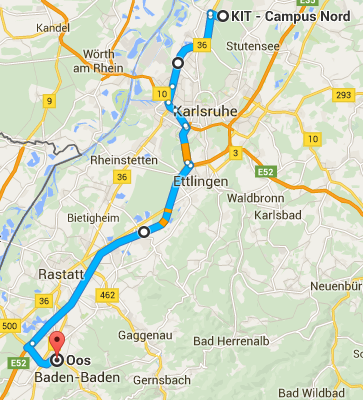Ready, Steady, GOOOOO
Traffic jams and rush hours reduce my free time, which I can spend with more meaningful activities. Usually I use the commute to come down from work and to switch into private mode. Unfortunately I do not need an hour to arrive in the private world, such that I waste a lot of time in the car. Even the best podcasts are sometimes of no use to bridge the time. In order to reduce the commute time from my office to my home, I tried experimentally to figure out which departure time is the best. Beside the desired sampling rate and a long observation period, I am lazy and I forget to make notes. After a week the experiments felt fuzzy and the way of solving the problem did not satisfy the little nerdiness I carry with me but I got the best case and worst case timings:
Travel distance: 50 km Best case (moderate speed): 35 minutes Best case (pedal to the metal): 30 minutes Worst case: 60 minutes
What do humans in the 21st century use to estimate the travel time? Google maps! OK thats the way to go. The nice thing is, that google maps is able to take the current traffic situation into account. I can let the computer do the nasty work of taking notes.
Within 80 lines of Java code (with empty lines ;-), the google maps API is queried every minute and the result is stored in a file. After about $3.5$ weeks of data acquisition a bash script extracts and groups the estimated travel time for each day of the week into a single file. One data point consists of the time and estimated travel time pair: “HH-MM-SS : estimated travel time”. Up to 4 data points of each minute made the visualization messy. To reduce the number of data points a python script computes the mean value for each minute. Finally D3 javascript is used to visualize the data as you can see if you click on one of the following weekdays.
Monday, Tuesday, Wednesday, Thursday, Friday, Saturday, Sunday
Between 1 am and 5 am google does not deliver travel time estimations or the more probable explanation is, that google knows about a stargate nearby, which opens from 1 am to 5 am. Beside the things google knows, the interesting parts for me are the rush hour peaks around 5 pm. On Monday there is surprisingly no peak. Maybe the measurement period of about $3.5$ weeks was to short. On Tuesday and Wednesday the peaks are after 5 pm and on Thursday and Friday the peaks are shifted towards 4pm. Surprisingly a 12 o’clock peak occurs on saturday. A colleague called it “the Saturday shopping rush”, which matches pretty well with my observations of shopping on a saturday. Sunday is no surprise at all.
As a result for me: Find the Stargate! Go early to work and leave early. If you want to stay in the bed for a few moments, consider a few moments more.
Supplement: The experimental observation indicates, that during school vacations the rush hour is significantly shorter.
